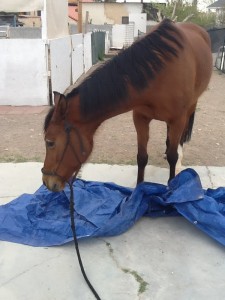You know how to read a horse’s body language, right? If you don’t, you don’t want to try to bombproof because you might make a mess. These isn’t rocket science, but it can be tricky and the consequences can be bad.
Horse Bombproofing 101
There are two general methods of getting through fear….flooding and systematic desensitization. In flooding, you simply put the horse (or the person) into the traumatic situation and leave them there until they burn through all of their adrenalin and relax.
Smaller, less traumatic ways of doing flooding might be to post plastic bags around the horse’s corral so that they are blowing in the wind while the human may not even be around. This can be helpful but it’s not clicker training so we’re not going into those details.
Systematic Desensitization and Clicker Training for Horses
Clicker training uses an approach called Systematic Desensitization, which is a progressive method that never overloads or floods the animal. In systematic desensitization (SD), the exposure to the feared thing is gradual and waits for a calm response before proceeding to the next step.
With SD, we don’t ever want to flood or overwhelm the horse.
We also want to make sure we are clicking RELAXATION. This is so important. If you click the horse stepping backwards away from the scary thing, you are reinforcing fear responses. Even if you don’t click, but you retreat the scary thing by moving it away and then click, you are reinforcing the wrong thing.
Just as in every aspect of clicker training, first figure out your tiniest steps and if the horse looks overwhelmed at any time, back up.
So, in tarp training, your smallest steps might look like this:
- handler holds a folded up tarp in her hand within eyeshot of the horse
- handler holds a folded up tarp a bit closer and sees if the horse will move towards it either by moving the muzzle towards it or moving the feet to get closer
- horse sniffs the folded up tarp
- handler pets the horse with the folded up tarp
- handler unfolds the tarp a little bit so that it’s still folded, but a bit bigger, and repeats the steps above
- handler holds the tarp near the horse and makes the (still folded) tarp make a small crinkly noise
- handler repeats all the steps above while making crinkly noises
- handler unfolds the tarp some more, preferably on a day when the wind isn’t blowing and does all of the above again
In fact, if you get more than a tiny fear response, you need to back up. We are not practicing flooding! We are practicing systematic desensitization.
If my horse snorts at the scary thing, that’s okay and I don’t back down. But I will wait until she looks more relaxed to click.
If she flinches, the thing will repeat over and over again until she’s not flinching.
If she’s backing away or even looking like she wants to back away, she’s telling me that I’m going to fast and need to back off.



